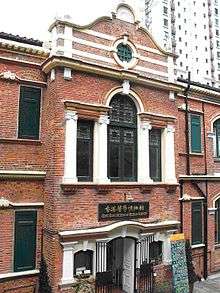Hong Kong Museum of Medical Sciences
| 香港醫學博物館 | |
 Hong Kong Museum of Medical Sciences | |
| Former name |
Bacteriological Institute(1906-1940s) Pathological Institute(1940s-1960) Old Pathological Institute(1960-1996) |
|---|---|
| Established | May 1995 |
| Location |
2 Caine Lane, Mid-levels, |
| Coordinates | 22°17′00″N 114°08′55″E / 22.283443°N 114.148606°E |
| Type | Heritage |
| Architect | Leigh & Orange |
| Owner | Hong Kong Museum of Medical Sciences Society |
| Website | Official website |
| Hong Kong Museum of Medical Sciences | |||||||||
| Traditional Chinese | 香港醫學博物館 | ||||||||
|---|---|---|---|---|---|---|---|---|---|
| |||||||||

The Hong Kong Museum of Medical Sciences (Chinese: 香港醫學博物館) was established in 1996, and is located in a renovated 3-story Edwardian-style building, at 2 Caine Lane at the Mid-levels, Hong Kong Island, Hong Kong. It is also referred to as Old Pathological Institute.
The aim of the museum is to promote the collection and preservation of materials of historical interest relating to the development of the medical industry in Hong Kong. On occasion, some exhibitions are held by the museum, in order to present basic and advanced medical information and news. One of its major goals is to help raise public interest in the medical history of Hong Kong and teach them more about health and diseases.
History
The building that would later become Hong Kong Museum of Medical Sciences was built in 1906. It was designed as a Bacteriological Institute, and renamed to Pathological institute after World II. The building was designed by Leigh & Orange.[1]
Being the first laboratory of bacteriology in Hong Kong, it was constructed of red bricks and consisted of three blocks. The main block is a two-storey building with a basement. The second one was used as a dormitory and the third for keeping animals. In 1972, the institute was relocated to Victoria Road and the building was then used as a storeroom for Pathology Service for the Health Department.
The building was declared a monument in 1990. In 1995, it was handed over to the Hong Kong Museum of Medical Sciences Society and converted to a museum for the public.
Features
It is a three-tier building occupying 10,000 square feet (930 m²) and it consists of 11 exhibition galleries including a gallery for Tai Ping Shan View, a game room, a library and the Gordon King Lecture Theatre.
The galleries[2] include:
- Lui Hac Minh Gallery
- Hong Kong Tuberculosis, Chest and Heart Diseases Association Gallery
- Hong Kong College of Radiologists
Goal
The aim of the museum is to exhibit and educate the public about Hong Kong's medical history as well as to preserve historical medical materials relating to the local development of medicine. Occasionally, special activities are held by the museum to inform the public about medical information and news. Publications and leaflets are also distributed to the public occasionally so as to help arouse the interest of the public in the medical history of Hong Kong and increase their knowledge and understanding of health and diseases.
Transportation
The museum is accessible within walking distance South West from Sheung Wan Station of MTR.
Gallery
 A specimen in the Museum
A specimen in the Museum Another specimen in the Museum
Another specimen in the Museum An exhibit in the museums:Bound Feet
An exhibit in the museums:Bound Feet An exit of the Museum
An exit of the Museum The Museum and its herbal garden
The Museum and its herbal garden An entrance of the Museum
An entrance of the Museum Tung Wah Group of Hospitals' Gallery
Tung Wah Group of Hospitals' Gallery The exhibits explain the history of Tsun Yuk Hospital
The exhibits explain the history of Tsun Yuk Hospital
See also
References
- ↑ "From British Colonization to Japanese Invasion" (PDF). HKIA Journal (45: 50 years of Hong Kong Institute of Architects): 47. 2006-05-30. Archived from the original (PDF) on 2012-02-18.
- ↑ Film Service Office location library: Hong Kong Museum of Medical Sciences
External links
| Wikimedia Commons has media related to Hong Kong Museum of Medical Sciences. |
- Official website of the museum
- Antiquities and Monuments Office: Old Pathological Institute
- Hong Kong Museum of Medical Sciences at Google Cultural Institute
- Virtual Heritage Explorer
Coordinates: 22°17′00″N 114°08′56″E / 22.2834°N 114.149°E